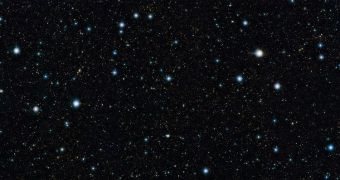A group of astronomers using the European Southern Observatory's (ESO) Visible and Infrared Survey Telescope for Astronomy (VISTA) just released the widest deep view of the night sky ever produced.
The image, collected at infrared wavelengths, contains more than 200,000 galaxies, and covers a portion of the sky that was previously thought to be unremarkable. It was compiled during the UltraVISTA survey.
ESO scientists are currently in the process of releasing a massive cache of similar images. All photos have been fully processed and enhanced, so that the international astronomical community may use them for other studies.
The primary goal of UltraVISTA is to map the location of extremely-distant galaxies that started developing just a few hundred million years after the Big Bang. Such investigations could lead to a better understanding of how galaxies, and indeed the Universe, evolved.
This particular image was taken in the COSMOS field, which is located in the constellation of Sextans. It covers a total of 1.5 square degrees, which is roughly the equivalent of 8 times the area the full Moon occupied in the night sky.
“ESO’s VISTA telescope has been trained on the same patch of sky repeatedly to slowly accumulate the very dim light of the most distant galaxies,” a statement from the Observatory explains.
“In total more than six thousand separate exposures with a total effective exposure time of 55 hours, taken through five different coloured filters, have been combined to create this picture. This image from the UltraVISTA survey is the deepest infrared view of the sky of its size ever taken,” it adds.
VISTA is located at ESO's Paranal Observatory, in Chile. It is a 4.1-meter, Quasi-Ritchey-Chrétien telescope, capable of conducting investigations in the infrared portion of the electromagnetic spectrum. It is the largest observatory in the world dedicated to near-infrared observations.
“Close inspection of the picture reveals tens of thousands of previously unknown reddish objects scattered between the more numerous cream-coloured galaxies. These are mostly very remote galaxies seen when the Universe was only a small fraction of its present age,” the ESO statement concludes.

 14 DAY TRIAL //
14 DAY TRIAL //